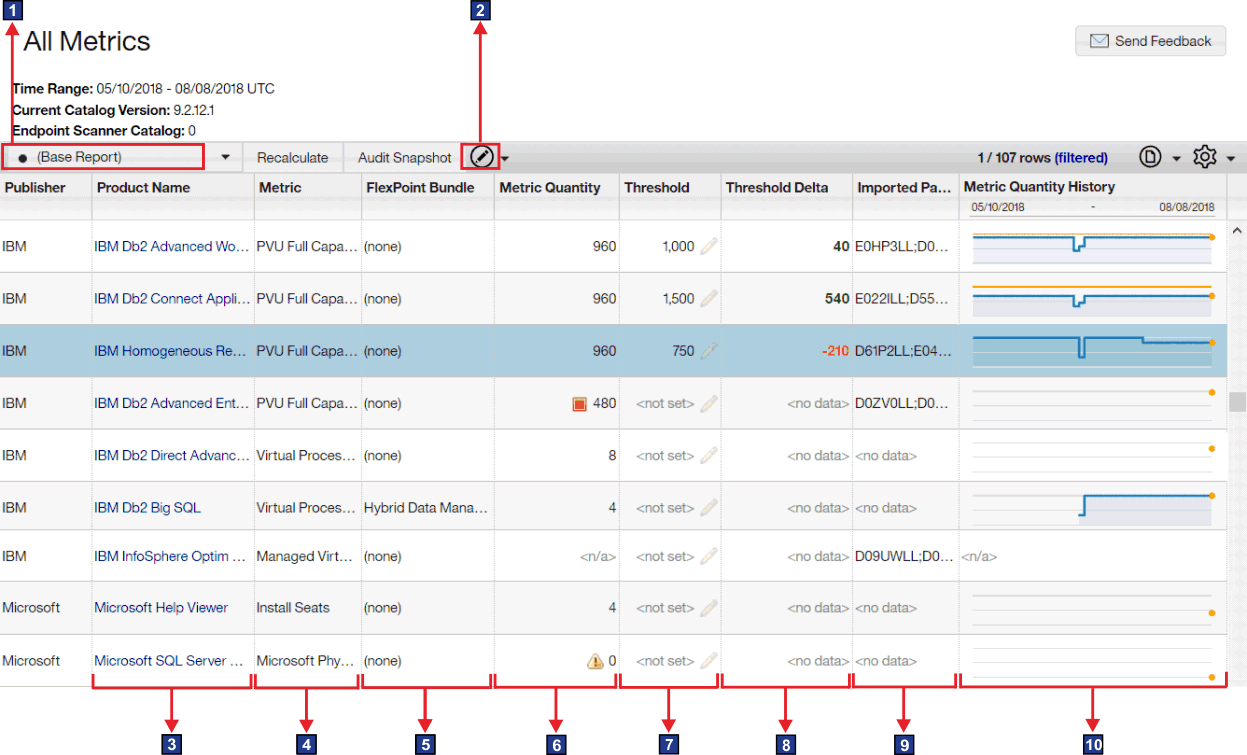License metric utilization
The primary source of information about license metric utilization is the All Metrics report. For every product, you can specify a metric threshold to verify whether metric utilization is above or below your expectations. You can also create a snapshot of the report, and store it for audit purposes.
Report overview


 Predefined report views
Predefined report views- Predefined report views give you quick access to filtered information. You can schedule these reports to be sent and set them as default views. However, you cannot modify them.

 Thresholds and Custom Fields
Thresholds and Custom Fields- Custom fields allow you to extend information that is related to software products by adding details pertinent to your organization. You can then use the information to filter and sort the reports as well as group products based on flexible criteria. A value that is specified in a custom field applies to the selected product with the particular license metric. It also applies only within the computer group to which you are assigned. For more information, see: Adding custom information to license metric reports.
 Product Name
Product Name- Name of the licensed product. When you click the link for a product that uses the PVU or RVU
MAPC metric, the next level of the report shows servers on which the product was installed when the
metric quantity was the highest.
When you click the link for any other product, the next level shows all instances of product components, including historical instances that are no longer installed. To view the list of component instances that were installed when the metric quantity was the highest, generate the audit snapshot.
 Metric
Metric- License metric that is assigned to the product. The metrics fall into three categories:
- Metrics for which utilization is calculated, including:
 Install Instances
Install Instances Install Seats
Install Seats Microsoft Dual Physical Processor
Microsoft Dual Physical Processor Microsoft Single Physical Processor
Microsoft Single Physical Processor Microsoft Physical Core with SA
Microsoft Physical Core with SA Microsoft Virtual Core with SA
Microsoft Virtual Core with SA Oracle Processor Core
Oracle Processor Core- Processor Value Unit (PVU)
 Registered User
Registered User- Resource Value Unit (RVU MAPC)
 Virtual Processor Core (VPC)
Virtual Processor Core (VPC)
 Metrics for which calculating utilization is not yet supported. These
metrics are available only for BigFix products.
Metrics for which calculating utilization is not yet supported. These
metrics are available only for BigFix products. Metric is unknown
Metric is unknown
For more information about the license metrics, see: Reported license metrics.
Tip: If you want to display only products for which metric utilization is calculated, hover over the Manage Report View icon , and click Configure View. Then, set the following filter:
, and click Configure View. Then, set the following filter:
Metric Quantity,greater than or equal to,0. - Metrics for which utilization is calculated, including:

 FlexPoint Bundle
FlexPoint Bundle- FlexPoint bundle to which the product and its components are assigned. For more information, see: Assigning products to FlexPoint bundles.
 Metric Quantity
Metric QuantityThe highest number of metric units that the product used during the specified period. The value
The following icons indicate that further actions are required to ensure that the metric quantity is up-to-date:<n/a>indicates that the quantity is not calculated for this metric.- Red square (
 ) indicates that the metric quantity for the product needs to be updated because an action
that influences the value was performed. For example, a component was assigned to this product. To
update the metric quantity, click Recalculate. The progress of recalculation
is displayed below the top menu bar.
) indicates that the metric quantity for the product needs to be updated because an action
that influences the value was performed. For example, a component was assigned to this product. To
update the metric quantity, click Recalculate. The progress of recalculation
is displayed below the top menu bar. - Exclamation mark (
 ) indicates that metric quantity might not be calculated correctly because inventory data
from at least one VM manager is not reported properly. To solve the problem, ensure that all VM
managers are configured. For more information, see: Adding VM managers in central mode or Adding VM managers in distributed mode.
) indicates that metric quantity might not be calculated correctly because inventory data
from at least one VM manager is not reported properly. To solve the problem, ensure that all VM
managers are configured. For more information, see: Adding VM managers in central mode or Adding VM managers in distributed mode.
- Red square (

 Threshold
Threshold- The maximum number of metric units that the product can use within the computer group. The value is set manually. For more information, see: Setting license metric threshold.

 Threshold Delta
Threshold Delta- The difference between the threshold and the metric quantity. It indicates whether the metric
utilization is above or below the manually set threshold. The following values indicate that the
delta cannot be calculated:
- The value
<no data>indicates that the threshold is not set. - The value
<n/a>indicates that the threshold was set for a product for which metric quantity is not calculated.
- The value
 Imported Part Numbers
Imported Part Numbers- Part numbers that represents products that you purchased. For more information, see: Part numbers.
 Metric Quantity History
Metric Quantity History- History of changes in the metric utilization over the specified period. The history is not available for products for which metric quantity is not calculated.